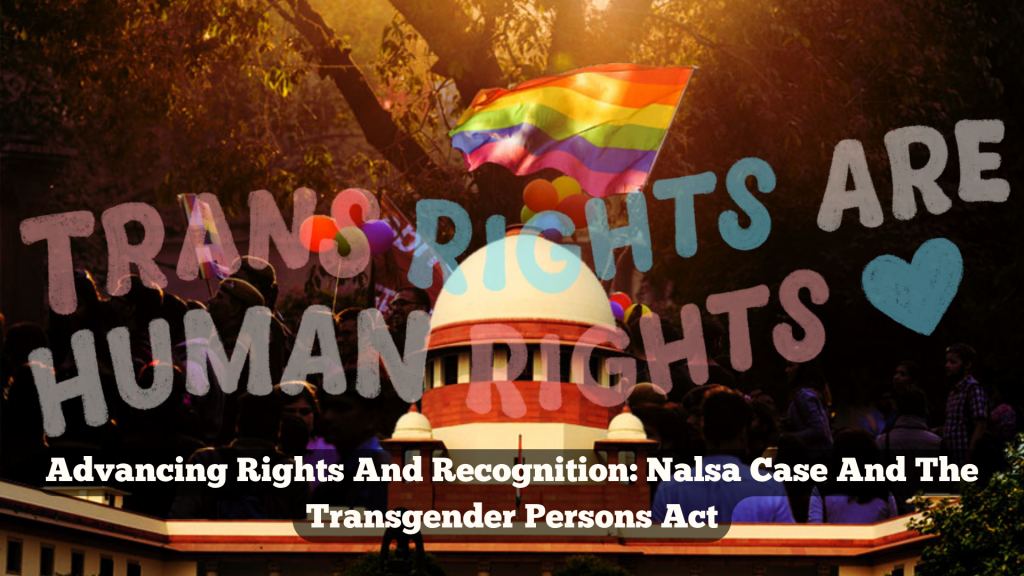
Advancing Rights And Recognition: Nalsa Case And The Transgender Persons Act
Judgement Given On : 15/04/2014
Introduction:
In 2014, the Supreme Court of India delivered a groundbreaking judgment in the case of National Legal Services Authority (NALSA) v. Union of India. This landmark decision redefined the interpretation of Article 21 of the Indian Constitution, asserting that an individual’s self-defined sexual orientation and gender identity are intrinsic to their personality, fundamental to their right to life and liberty. The court’s transformative interpretation of Article 21 not only affirmed the fundamental rights of transgender individuals but also acknowledged the existence of a third gender, separate from the binary male and female identities.
Subsequently, the Indian government enacted the Transgender Persons (Protection of Rights) Act, 2019, and the accompanying Rules in 2020, often referred to as “The Transgender Act.” This legislation aims to combat discrimination against transgender individuals in areas such as education, employment, and healthcare while recognizing their right to self-perceived gender identity.
Case background:
The NALSA case of 2014 marked a significant milestone in the recognition and protection of transgender rights in India. Transgender individuals, often marginalized and subjected to discrimination, found hope in this landmark judgment. The case revolved around the interpretation of fundamental rights in the Indian Constitution, particularly Article 21, and aimed to safeguard the rights and interests of those who identified as the third gender.
Two writ petitions were filed to protect and uphold the rights of transgender individuals. The National Legal Services Authority (NALSA) initiated the first petition (writ petition no. 400 of 2012), followed by a second petition (No. 604 of 2013) filed by the Poojya Mata Nasib Kaur Ji Women Welfare Society, an association dedicated to protecting the rights of the Kinnar (transgender) community. Laxmi Narayan Tripathi, who identified as Hijra, also joined the case, highlighting the denial of his rights under Articles 14 and 21 of the Constitution.
Key Issues:
The central issues in these petitions revolved around gender identity and the necessity to protect the rights of individuals who identified as transgender. The case examined whether individuals born male but with female orientation had the right to be legally recognized as female, even without undergoing surgery. It also addressed the question of whether individuals who did not identify as either male or female had the right to be classified as a “third gender.”
Petitioners’ Arguments:
The petitioners argued that the societal concept of binary genders violated the fundamental rights enshrined in the Constitution, including the Right to Equality (Article 14), Right to Life and Personal Liberty (Article 21), and Freedom of Expression (Article 19). They contended that the binary gender norm marginalized and victimized transgender individuals, robbing them of basic human dignity and relegating them to the fringes of society.
Respondents’ Arguments:
The respondents, including the state and union territories, countered by stating that an “Expert Committee on Issues Relating to Transgender” was actively considering opinions to improve the lives of transgender individuals. They emphasized that states and union territories had already implemented several measures for the welfare of the transgender community.
Case Judgment:
The judgment was delivered by a two-judge bench comprising Justice K.S. Radhakrishnan and Justice A.K. Sikri on April 15, 2014, with Justice Sikri providing additional comments. The court distinguished between biological sex and psychological sex, prioritizing the latter for gender identification. The judgment recognized the importance of international conventions, including the Yogyakarta Principles, as long as they aligned with the fundamental rights guaranteed by the Indian Constitution. Transgender individuals were declared to be within the purview of the Indian Constitution, entitled to the same rights as all citizens. Article 14, guaranteeing equality, was affirmed to apply to “any person,” including transgender individuals. Transgender individuals were granted equal rights in employment, healthcare, education, and civil rights. Discrimination based on sexual orientation and gender identity was deemed a violation of Article 14. Transgender individuals were recognized as having the freedom of expression under Article 19. The right to live with dignity under Article 21 was affirmed. The judgment directed both central and state governments to grant full recognition to transgender individuals, ensuring access to education and healthcare without discrimination. Hijras and eunuchs were officially categorized as the “third gender.” The judgment mandated the establishment of separate HIV Zero-Surveillance Centres, provision for separate public toilets, and appropriate medical care in hospitals for transgender individuals.
Intersection of POSH Act and Transgender Rights:
While the POSH Act is not gender-neutral and exclusively protects women, the Transgender Act, when considered alongside the NALSA judgment, could potentially extend protection to transgender women, whether or not they have undergone gender-affirming surgery. This alignment finds support in the High Court of Delhi’s decision in Anamika vs. Union of India, which held that a transgender person identifying as a woman can register a complaint under Section 354A of the Indian Penal Code.
Need for Legal Updates:
As organizations increasingly recognize the importance of safeguarding all employees from sexual harassment, regardless of gender, it may be necessary to revisit and possibly amend the POSH Act. While the acts define safe workplaces differently, their shared objective is to uphold freedom and dignity in the workplace. Both statutes establish grievance redressal mechanisms, including Internal Committees under the POSH Act and Complaint Officers under the Transgender Act. While the former’s composition is well-defined, the latter’s eligibility lacks specificity.
Conclusion:
The intersection of the POSH Act and transgender rights is a complex but evolving landscape. The intent of legislation and judiciary decisions is clear: to protect the rights of marginalized communities and ensure their safety and dignity. As society evolves, so too must the law. Whether through the amendment of existing laws or the creation of new ones, the path to achieving comprehensive protection for all individuals, irrespective of their gender identity, continues to unfold. Clarifications from the courts on these matters will undoubtedly play a crucial role in shaping the future of gender equality and workplace safety in India. The NALSA case marked a significant step toward recognizing and safeguarding the rights of transgender individuals in India. While the judgment did not singlehandedly eradicate the discrimination and prejudice faced by the transgender community, it provided a legal foundation upon which to build a more equitable and inclusive society. Despite the challenges that remain, this judgment serves as a beacon of hope and progress in the ongoing struggle for transgender rights and dignity in India.
